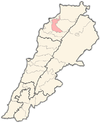Aitou
Aitou
أيطو | |
|---|---|
Village | |
UTC+3 (EEST) | |
| Dialing code | +961 |
Aitou (also Ayto, Aytou, Aytu, Aïtou, Aito, Itoo,
Demographics
The current estimate is that 1157 people live in Aitou in about 200 houses. The people of Aitou are typically followers of the
Famous People from Aitou
The most renowned individuals from Aitou or descendants of Lebanese from Aitou are:
- Ray LaHood, U.S. Secretary of Transportation
- Joseph Hitti, bishop
- Bishop Hanna Alwan, Curial bishop of the Maronite Catholic Patriarchate of Antioch
- Father Khalil Alwan, General Secretary of Council of Catholic Patriarchs of the East
Etymology
With a Qaf (Qaitou), the name in
With a Ghayn (Ghaithou), it could mean anger, rage (Arabic equivalent: غيظ).
With an Aleph ('Aitou), it could mean thick, obscure, magic in reference maybe to the thick forests or the thick fog that characterizes the summer evenings in this area.
Geography
Aitou is a mountainous village, located 113 km from Beirut and 27 km from Tripoli, Lebanon. The town occupies the northern slopes of Mount Lebanon at an elevation ranging between 900 and 1300 meters above sea level.[2]
History
Antiquity
In
Ottoman period
After the settlement of the
In 1517, one year after the beginning of the Ottoman rule in Lebanon, the Muqaddam of Bsharri, Elias, died leaving the rule of the region to his young son Hanna, known later as Abdel Muneem.[5] In 1519, the Muqaddam of Aitou, Kamal Eddine Ibn Abdel Al-Wahhab, known as Ibn Ajramah (ابن عجرمة), profiting from the confusion and the young age of the Muqaddam of Bsharri, seized the power in Jebbet Bsharri. He was married to Sitt El Moulouk (ست الملوك), a cousin of the Muqaddam of Bsharri. Sitt Al Moulouk played an important role in the take-over out of revenge because the family branch of her father, the Sheikh Alwan, was evicted from power in Jebbet Bsharri previously.[6]
In the first Ottoman census of Jebbet Bsharri done in that same year, Aitou was credited with 28 male adults, 24 of them married.[7]
The Muqaddam of Aitou, Ibn Ajramah, ruled Jebbet Bsharri for 18 years. He built a castle[8] in Aitou and accumulated copious amounts of wealth.
In 1532, Abdel Muneem (عبد المنعم) of Bsharri succeeded in getting back the rule on half of the region from Bsharri to Hadath El Jebbeh, the other half from Blaouza to Aitou staying under the rule of Ibn Ajramah of Aitou.[9] In 1537, Abdul Muneem of Bsharri killed Ibn Ajramah of Aitou by stabbing him with his spear. The killing took place in the village of Blaouza. Ibn Ajramah was buried in Aitou behind the church of Mar Sarkis.[10] This episode marked the end of the Muqaddams of Aitou.
But the wife of Ibn Ajramah, the above-mentioned Sitt El Moulouk, took eventually her revenge by paying mercenaries to assassinate Abdul Muneem in 1547, ending also this dynasty of Bsharri's Muqaddams as no male descendant was alive.[11]
In the second Ottoman census of 1571, Aitou had 46 male adults, 40 of them being married.[7]
Religious Structures
Churches
- Church of Our Lady of Aitou
- Church of Saint Rafqa
- Church of Saint Domitius
- Church of Saint Joseph
- Church of Saint Sergius and Saint Bacchus Saint Sarkis & Bakhos
- Church of Saint Simon
Monasteries
- Monastery of Saint Simon
- Monastery of Saint Artemios of Antioch (Challita)
References
- ^ "Municipal and ikhtiyariah elections in Northern Lebanon" (PDF). The Monthly. March 2010. p. 23. Archived from the original on 3 June 2016. Retrieved 28 October 2016.
{{cite web}}: CS1 maint: bot: original URL status unknown (link) - ^ a b c d About Aitou
- ^ Moubarac, Youakim (1984): Pentalogie Antiochienne/Domaine Maronite, Tome II, Volume 2, Cenacle Libanais, Beirut, Page 587.
- ^ Al Qattar, Elias (1998): Muqaddamiat Jebbet Bsharri fi Al-Ahed Al-Othmani, First Congress of Jebbet Bsharri, Gibran National Committee, Bsharri, page 306.
- ^ El Douaihy, Estephane (1982): Tarikh Al Azminah, version of Abbot Boutros Fahed, Dar Lahd Khater, Beirut, page 398.
- ^ Al Qattar, Elias (1998): Muqaddamiat Jebbet Bsharri fi Al-Ahed Al-Othmani, First Congress of Jebbet Bsharri, Gibran National Committee, Bsharri, page 315.
- ^ OCLC 35578546
- Muslim. Usually, Historians agree that the commonly called Maronite Muqaddams used to take Muslim names since the Mamluks period in order to facilitate their relations with the Muslim rulers but they were in fact either Christian Maronitesor Christian Jacobites. We know from Douaihy that, after his assassination, Ibn Ajramah was buried behind the Church of Mar Sarkis and not inside it as we could expect for a leader of such importance in those times.
- ^ El Douaihy, Estephane (1982): Tarikh Al Azminah, version of Abbot Boutros Fahed, Dar Lahd Khater, Beirut, page 410.
- ^ El Douaihy, Estephane (1982): Tarikh Al Azminah, version of Abbot Boutros Fahed, Dar Lahd Khater, Beirut, page 412.
- ^ El Douaihy, Estephane (1982): Tarikh Al Azminah, version of Abbot Boutros Fahed, Dar Lahd Khater, Beirut, page 417-418.
External links
- Aytou, Localiban
- Ehden Family Tree Archived 2020-08-09 at the Wayback Machine

